A Trip on the Canal Grande
Boat Trip on the Main Waterway of Venice

A trip with the vaporetto on the Canal Grande is a must of each standard-program of all visitors of Venice. By driving alongside the barely 3 km long road, one already sees some of the most important sightseeings of the city and from the best perspective, as the palaces have their gorgeous wall coverings faced to the channel and not at the back side.
In the following we will do a virtual boat trip alongside the Canal Grande and look at some sightseeings alongside the stretch. I have only described some highlights alongside the stretch; in reality, there is much more to see: numerous houses at which front one would love to stop the boat. Sometimes one does not know if one should look to the right or to the left; the best is to do the boat trip in both directions. And even better: once in the morning and once in the evening, so that one sees both sides of the shore in the sunlight.
Piazzale Roma
We start our boat trip at the Piazzale Roma. Here, there is one of the huge parking houses, in which one can park the car for a lot of money if one goes by car to Venice. Here, we get into a vaporetto and hope that we get a seat at the very front part so hat we either have a view to the right as also to the left.
We have several lines for choice that all navigate down the channel. There are ships that stop at each station and others that only stop at the most important points. The first ones seem at first to be advantageous, as the trip takes more time. But in fact, the shipd that only pass through are the better ones, as most of the time, they are in the middle of the channel so that one has a better view to the building as from the proximity of the shore.
Of course, the best is to do the trip several times, one time with the line of the second category in order to see as much as possible from the water, and another time with one that does a stop at each station in order to step out and have a little walk.
Chiesa degli Scalzi
As we just accessed the vaporetto and hopefully get a good seat at the bow, we already do the first stop that is at the main station of Venezia, the station Ferrovia degli Scalzi. Here, those visitors get in who arrived by train to Venice. Up to then, there is also not much to see, but from now, the sightseeings string together in short intervals and the memory card of the digital camera hopefully has enough space...
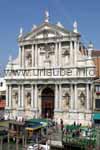
Right beside the main station we find a small church named Chiesa degli Scalzi. The baroque wall covering with the big entrance portal appears glorious and impressive. The church is from the 17th century and is worthwhile a visit: in the interior, there is a lot of gold and marble, thus this real splendid church right at beside the station is a short sidetrip worth.
Right in front of the church also the first of the three big bridges is already visible over the Canal Grande, the Ponte degli Scalzi. There are in fact only three bridges on which it is possible to cross the big channel. Between the bridges there are some stations where one can get transferred with gondolas. From the bridge there is a gorgeous view to the church and to the big main station plaza. Of course, it is a must to cross each of the bridges at least once and to have a look to both directions of the channel.
Palace beside Palace up to the Rialto-Bridge
At only approximately 300 m behind the Scalzi-Bridge, a wide channel branches at the left named Canale di Cannaregio, on which we navigate for example if when we have a boat trip to Murano, but more on that later. At approximately 50 m inwards the channel we find the Palazzo Labia, of which we after all see two sides of the wall coverings. It is about a former domicile of a Catalan merchant family.
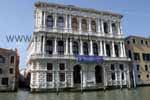
Our ship stops again at the station San Marcuola and right behind it we find at the left the Palazzo Vendramin-Calergi, a glorious Renaissance-palace that is approximately 500 years old. Here, the famous opera composer Richard Wagner temporarily lived and here he died in February 1883.
We navigate a further piece and find at the right shore side the Fondaco dei Turchi. It is the biggest palace at the Canal Grande and as it should be, it crows with an impressive frontal wall covering. In the interior of the building there is the the natural history museum of Venice.
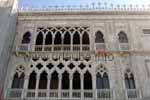
Also in the next glorious palace, the Palazzo Ca' Pesaro, there is a museum for modern and oriental arts. As until then, one is already a little used to the glorious wall coverings, one is delighted by the fact that this building has also a beautiful wall covering at the sides. Most of the palaces do only boast with the side that is faced to the channel; it is better not to look at the side walls.
The last highlight in front of the famous Rialto-bridge is the Ca' d'Oro (translated: golden house). The building is indeed not made of gold, but each of the wall coverings are so filigree and detailed that one gets an impression of high value that is measurable with gold. Originally, that is to say before the last bigger redecoration, the wall covering was really adorned with gold foil. The beautiful building is, by the way, more than half a millenium old.
The Rialto-Bridge
After navigating a few hundred metres we arrive at the first big arch mirror-inverted S of the Canal Grande. The suspense is high, as a big highlight of our vaporetto-trip is yet to come, the Ponte die Rialto. It was the first bridge that was built in Venice in order to cross the big channel. Originally, it was a small wood bridge; today, it is a pompous building that is much more than just a bridge on which one crosses the channel.
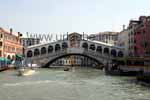
At this spot there was originally a trade centre in Venice where a lot of goods were handled. Today, even goods are handled on the bridge: some small shops are in file on the Rialto-bridge; of course, here only souvenirs and utensils for the tourists are sold.
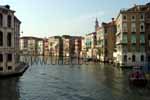
The bridge is impressive, either in its width as also in its height. And of course, people love to lean on the balustrade of the bridge and look to both directions of the channel. One can imagine that one is not alone here. The colours of the houses at the boardwalk at different times of the day are beautiful. But the most fun is to to watch the ships and gondolas passing underneath.
The Rialto-bridge is, by the way, also still today a kind of central point of Venice. It communicates both city districts San Polo and San Marco. And during the walks through the alleyways of the oldtown one repeatedely finds some guidepost leading one to the Rialto. Right behind the Rialto-bridge there is also the equaly named vaporetto-Station, at which a lot of people leave the boat and as many get into the boat. Then one clearly notices that he just passed a central point of the city.
From the Rialto-Bridge up to the Accademia-Bridge
After viewing the great Rialto-bridge we have already seen two of the three bridges that lead over the big channel. Now the boat trip continues alongside inner area of the big S until after some time we see two worthwhile seeing palaces at once. Now one has to be fast in order to somehow be able to be within a few seconds at both the left and the right side of the ship and of course hoping that the other 100 tourists in the vaporetto do not have the same idea, as this would turn into chaos...
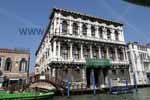
At the left side we first find the Palazzo Grassi, in which there are every year two culture and arts exhibitions. In front of the Palazzo Grassi we find the Ca' Rezzonico, a cube-shaped glorious palace with some pompous wall coverings at the front and the sides. In its interior there is a museum of Venecian handcrafts.
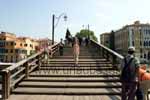
A few metres further in the Gallerie dell'Accademia, the matter is also about arts. Here, one can get a comprehensive overview about the Venetian paintings from the 14th up to the 18th century.
But during our boat trip we are temporarily less interested in arts and paintings but much more on buildings. And at the Accademia we also already find the third of the Canal Grande bridges, that is named Ponte de Accademia, as it is easily understandable. This bridge is - at least viewed from above - not a heavy concrete block but two wood balustrades with some wide and deep wooden stairs in between. Also from this bridge we simply enjoy the view to the channel in both directions and of course also the view to the navigating ships and gondolas underneath.
At the End of the Big S-Curve
After underpassing the Accademia-bridge we already see the end of the Canal Grande in front of us. But before, we look two times to the right side and even get out of the boat in order to do some sightseeings.
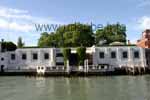
At first, there is at the right side the Palazzo Venier dei Leonithat is not completely finished, that indeed looks from outside very harmless compared to the palaces we had seen until then, but that in its interior accommodates one of the most significant art collections of modern arts. In the museum that is founded by Peggy Guggenheim there are some master works of famous artists such as Picasso, Kandinsky, Miro or Dali. For art lovers, a visit to this museum is a must.
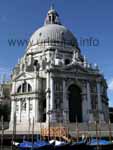
At the debouchure of the Canal Grande, a last highlight is waiting, the Chiesa di Santa Maria della Salute. The church was built in the 17th century as a gratitude of an ended pest epidemic and is one of the most beautiful baqroque churches that Venice offers. Already the exterior of the church is impressive and beautiful, but the interior is much more fascinating. The symmetry of the interior and the circular-shaped alignment of separate areas around the centre are unique.
We navigate further with the ship to the station San Marco, but basically our Canal Grande tour ends here. After we practically navigated through the core of Venice, as next, the circumnavigation of the city and/or a trip to the neighboured island is a worthwhile thing to do, as we have seen a lot from the vaporetto, but of course far not all.

Back to the index Venice
Copyright: Patrick Wagner, www.tourist-guide.biz
|